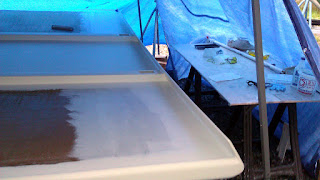 |
| The hole drilling contraption |
Of course, in filling the holes, I left a little too much resin on the top side and had to sand off the little "dome" that was created at each hole so we can get the fender washers to seat better against the top. Finally, we were ready to install the supports for the last time.
I decided to create thin rubber pads for the top of the supports where it meets the top. These pads would help the top of the supports conform to the surface of the top and hopefully more evenly distribute the load. I used the sheet of nitrile rubber we purchased to create the 1/16 inch pads and cut them to leave plenty of room around the screws (you don't want a seal at the bottom of the screw so any water that might leak through won't be trapped at the bottom). To bed the hardware and prevent leaking, butyl tape that I had previously purchased from Compass Marine was used. I find this stuff to be an excellent bedding material for anything that is through-bolted, just as is the case for all of these supports.
For each support, I run a strip of butyl tape around the perimeter of the mounting pad that meets the cabin top and encircle each screw hole. I then insert the screws in the mounting plate and carefully guide the support into position (this stuff is quite sticky, so I find using the screws as a guide is helpful). We then line up the top and insert the bolts that will hold the top to the supports and temporarily install the fender washers and locking nuts. Then, for each screw that holds the support to the cabin roof, we remove it, wrap the head with a little butyl tape, and reinsert it. Once all the screws have the butyl applied, the head of the screw is held stationary while the fender washer and locking nut are installed. The whole thing is then slowly tightened using a crisscross torque pattern until the butyl is compressed a little. Butyl tape is a bit putty-like, and we will need to re-tighten each of these a few times over the next day or so until it is fully seated in position.
Once the bottom of the support is attached, we return out attention to the screws holding the top to the support. One by one, each nut and washer is removed, the screw is wrapped with butyl tape where it meets the top, and the tape is pressed around the screw and the top, and the fender washer and lock nut are reinstalled. Just as before, we slowly tighten each nut using the crisscross pattern until everything is secure.
Three supports later, and the top that we have worked so long on is finally a permanent addition to our boat. Taking a step back and looking at the whole thing, I have to admit I'm proud of the work that my wife and I have done. We think the top looks pretty darn good. Apparently we aren't the only ones as we have received a number of compliments from people who have been here to see it in person. We've been told it complements the boat nicely and looks like it could have come from the factory. My wife even overheard one of the guys at the boatyard telling someone else that it looked like it came out of a mold.
Not bad at all for two amateur, first-time builders doing hand-laid-up fiberglass in a boatyard. I'd like to say the project is finished, but is any boat project ever really finished? We have an enclosure to add, and solar panels, and lighting. But the top itself is done!

















































